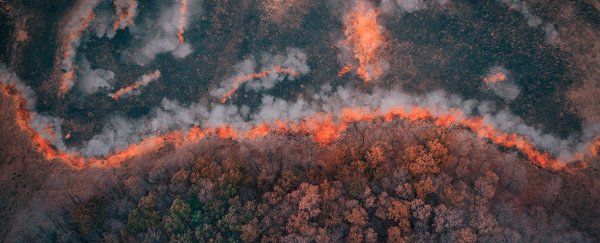Scientists have tracked down the oldest wildfires ever detected thanks to 430-million-year-old charcoal deposits from Wales and Poland. They give us valuable insight into what life on Earth was like during the Silurian period.
Back then, plant life would have depended heavily on water to reproduce and most probably wouldn't have appeared in regions that were dry for part or all of the year. The wildfires discussed in the study would have burned through very short vegetation, plus the occasional knee- or waist-high plant.
The landscape would have been dominated not by trees but by the ancient fungus Prototaxites, the researchers say. Not too much is known about the fungus, but it's thought to have been able to grow as high as nine meters (or almost 30 feet) tall.
 One of the samples used in the study. (Glasspool et al., Geology, 2022)
One of the samples used in the study. (Glasspool et al., Geology, 2022)
"It looks now as though our evidence of fire coincides closely with our evidence of the earliest land plant macrofossils," says paleobotanist Ian Glasspool from Colby College in Maine.
"So as soon as there's fuel, at least in the form of plant macrofossils, there is wildfire pretty much instantly."
To exist, wildfires need fuel (plants), an ignition source (which here would have been lightning strikes), and enough oxygen to burn.
That the fires were able to propagate and leave charcoal deposits suggests that Earth's atmospheric oxygen levels were at least 16 percent, the researchers say.
Today, that level is at 21 percent, but it has varied dramatically during the course of Earth's history. Based on their analysis, the team thinks the atmospheric oxygen levels 430 million years ago may have been 21 percent or even higher.
That's all very useful information for paleontologists. The thinking is that increased plant life and photosynthesis would have contributed more to the oxygen cycle around the time of these wildfires, and knowing the details of that oxygen cycle across time gives scientists a better idea of how life may have evolved.
"The Silurian landscape had to have enough vegetation across it to have wildfires propagated and to leave a record of that wildfire," says paleontologist Robert Gastaldo, also from Colby College.
"At points in time that we're sampling windows of, there was enough biomass around to be able to provide us with a record of wildfire that we can identify and use to pinpoint the vegetation and process in time."
The landscape that is now Europe looked a lot different hundreds of millions of years ago, and the two sites that the researchers used for their analysis would have been on the ancient Avalonia and Baltica continents at the time these wildfires were raging.
Wildfires then, as now, would have contributed significantly to the cycles of carbon and phosphorus, too, and to the movement of sediment on the Earth's surface. It's a complex combination of processes that takes a lot of unpacking.
This discovery certainly helps in that unpacking – smashing the previous record for the oldest wildfire on record by 10 million years – and it also highlights the importance that research into wildfires could have in charting the history of Earth.
"Wildfire has been an integral component in Earth-system processes for a long time and its role in those processes has almost certainly been underemphasized," says Glasspool.
The research has been published in Geology.
